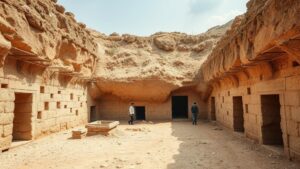Searching for the creators of the “Nuragic Bronzes,” miniature Sardinian sculptures from 1,000 BCE.
Searching for the Creators of the Nuragic Bronzes
The Nuragic Bronzes, a collection of exquisite miniature sculptures from Sardinia, date back to around 1000 BCE and provide profound insights into the ancient Nuragic civilization. These artifacts, often depicting warriors, gods, and animals, stand as a testament to the artistic and cultural achievements of the time. This article explores the origins, significance, and creators of these remarkable pieces of art.
The Nuragic Civilization: Context and Culture
The Nuragic civilization thrived on the island of Sardinia during the Bronze Age, roughly from 1500 to 300 BCE. Known for their distinctive megalithic structures, called nuraghes, the Nuragic people developed a rich cultural heritage characterized by a unique blend of Indigenous traditions and external influences from Mediterranean trade routes.
Key features of their culture include:
- Innovative architectural techniques applied in building thousands of nuraghes across the island.
- A sophisticated societal structure that likely included elite classes, as inferred from burial practices and material wealth.
- A robust maritime activity that facilitated trade with other civilizations such as the Phoenicians and the Etruscans.
The Discovery of the Nuragic Bronzes
The Nuragic Bronzes were first discovered in the early 20th century, with many finds occurring during archaeological excavations across Sardinia. The most significant discoveries happened in the towns of Barumini and Tharros, where numerous bronze figures were unearthed, typically found in burial sites or sanctuaries, emphasizing their ceremonial roles.
Noteworthy statistics indicate that over 200 distinct bronze figures have been cataloged, each ranging from just a few centimeters to more than a meter in height. These figures showcase not only aesthetic craftsmanship but also serve as important historical documents reflecting the religious and social practices of the Nuragic culture.
Artistic Techniques and Symbolism
The creation of the Nuragic Bronzes employed advanced metallurgy techniques for the time, utilizing the lost-wax casting method. This technique allows for intricate designs and fine details, which can be seen in the expressive postures of the figures.
Symbolically, the bronzes frequently depict:
- Warriors equipped with shields and helmets, indicating a society that valued martial prowess.
- Animal figures that could represent totemic beliefs or agricultural significance.
- Deity-like representations suggesting a religious dimension intertwined with civic life.
Who Made the Nuragic Bronzes?
Despite their significance, the specific creators of the Nuragic Bronzes remain largely unknown. Scholars suggest the figures were likely produced by skilled artisans working within a guild system, although there is limited evidence to confirm this. Craftsmanship appears to have been a highly esteemed profession connected closely to the social elite, perhaps involving special training passed down through generations.
Analyzing stylistic elements and craftsmanship, researchers have been able to propose various theories regarding regional differences and production techniques. For example, some bronze pieces display characteristics similar to other Mediterranean cultures, indicating the possibility of influences or exchanges in artistic practices.
The Importance of the Nuragic Bronzes Today
Today, the Nuragic Bronzes are not only critical to understanding Sardinias history but also serve as valuable educational tools for the public. Displayed in museums worldwide, such as the National Archaeological Museum of Cagliari, these bronzes spark interest in ancient civilizations and encourage discussions about art, culture, and societal dynamics of the past.
Real-World Applications and Future Research
The ongoing study of the Nuragic Bronzes presents numerous opportunities for interdisciplinary research, engaging experts in archaeology, art history, and anthropology. Advanced imaging techniques, such as CT scanning and 3D modeling, allow researchers to investigate the artifacts without causing damage, opening avenues for non-invasive analysis.
Plus, the involvement of local communities in preserving and promoting Nuragic heritage is essential. Establishing educational programs can enhance awareness and appreciation while encouraging sustainable tourism practices that benefit both the economy and cultural preservation.
Conclusion: The Legacy of the Nuragic Bronzes
The search for the creators of the Nuragic Bronzes continues to fascinate historians and archaeologists alike. Although the specific artisans remain shrouded in mystery, the significance of these artifacts in understanding the Nuragic civilization is undeniable. As research evolves, each new discovery adds to the rich tapestry of this ancient culture and its enduring legacy.
To wrap up, the Nuragic Bronzes stand as a powerful reminder of humanitys artistic achievement, and ongoing inquiries into their origins will undoubtedly unearth further remarkable insights into Sardinias storied past.



